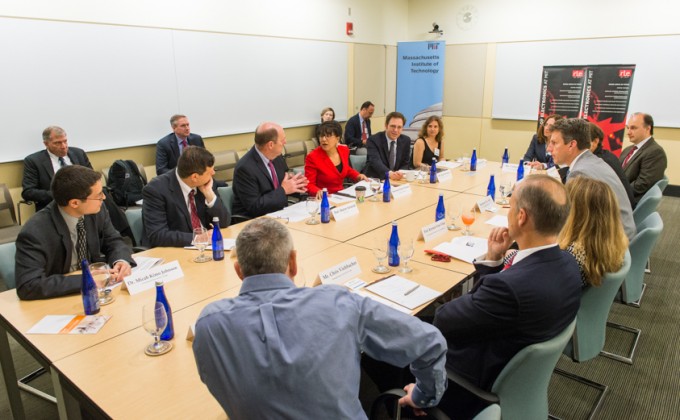Catherine Fazio | MIT Innovation Initiative Lab for Innovation Science and Policy
October 19, 2015
Innovation can seed breakthrough technologies, open new markets, improve living standards, and unlock novel avenues for solving some of the world’s greatest challenges. Yet, attempts by regions to realize economic growth via seeding innovation ecosystems often leave a “Boulevard of Broken Dreams,”[1] not a new Kendall Square. The rapid pace of technological change and evolving nature of work leave many concerned about whom—and how many—the growing innovation economy will leave behind. On September 18, 2015, the MIT Innovation Initiative Laboratory for Innovation Science and Policy hosted a roundtable discussion of these important issues with US Secretary of Commerce Penny Pritzker and thought leaders from MIT faculty and the regional innovation and entrepreneurial ecosystem. Chaired by MIT Provost Martin Smith, several important insights arose from the discourse.
- Current Efforts
Efforts to foster regional economic growth via innovation ecosystem development have led to uneven performance. Areas like Kendall Square and Silicon Valleyare complex ecosystems. Replicating pieces of them in other places often fail to catalyze a vibrant regional innovation and entrepreneurial economy. Seeding and sustaining innovation and entrepreneurial ecosystems requires a systems-level, stakeholder-based approach grounded in a data-driven analysis of the particular region’s areas of competitive advantage. The underlying foundation of legal structures and a culture that not only enables entrepreneurs to start businesses easily, but also permits them to fail, is critical.
The Challenges
Sustaining innovation that translates hard-science research discoveries into technologies with wide-scale social and economic impact can be particularly challenging. In many places, the infrastructure young firms need to get started is lacking. For example, in the life sciences sector, new start-ups often face difficulty finding affordable lab space and equipment to take their ideas from the research bench to the next level. Hard-science accelerators offering these resources can leverage economies of scale to lower the costs for such a start-up by up to a factor of 10. Importantly, this new breed of accelerator can also offer mentoring services and networking opportunities critical to a start-up’s success. Not all ecosystems need or can support hard-science accelerators in specific fields, however. They make the most sense in hubs where dense clusters of similar start-ups are already present. Building a hard-science accelerator independent of the environment in which it resides cannot seed the development of an economic cluster or entrepreneurial environment.
Funding gaps must be bridged to maintain innovation pipelines. In the Boston innovation and entrepreneurship ecosystem, it can be easier to raise $10 million than $100,000, leaving many nascent start-ups without critical early seed money to move research discoveries beyond the bench. Even if many of these ventures ultimately fail, it is crucial to invest as much in talent as it is in technology to sustain hard-science innovation.
The regulatory environment can be a gating factor to sustained innovation. Risk capital investors need to see a path forward or they will not invest. Transaction costs and other barriers increase when regulations are not kept up to speed with scientific advancements.
Role of Government
Government leadership is critical to synchronizing priorities and setting a roadmap for long-term investment. Hard-science innovation and entrepreneurship in general, and advanced manufacturing innovation in particular, require large capital expenditures and sustained investment. The Department of Commerce has been effective in leading the economy forward and encouraging investment and research particularly in the area of advanced manufacturing innovation. Similarly, the Affordable Care Act’s focus on wellness is spawning new industries, encouraging the development and use of technologies to promote beneficial behaviors.
- Computation
Computation is a new utility, impacting the nature of the types of jobs available. Importantly, it is creating a never-ending stream of new opportunities for which demand outpaces supply. In the face of these dramatic changes, the US should recognize that programming (digital literacy) has become a fundamental skill—one that is as important as reading, writing and arithmetic— and should be taught from an early age in school. New workforce training at the community college level can also help to ready more people for the variety of jobs that are emerging.
Conclusion
Overall, the discussion highlighted that building a sustainable and vibrant innovation and entrepreneurial ecosystem requires a systems-level approach. To succeed, efforts to catalyze hard-science innovation require key leaders from all five stakeholder groups—government, university, corporate, entrepreneurs, and risk capital—to jointly commit to develop and generate support for and implement a strategy that directly builds on the region’s comparative advantage and plugs existing gaps in an area’s innovative and entrepreneurial capacities. While academic and practitioner understanding of innovation and entrepreneurial ecosystems have advanced in recent years, much remains to be learned. Initiatives by universities such as MIT to generate scientific evidence about the drivers of innovation outcomes, and by the US Department of Commerce to empower policymakers, practitioners and researchers with data and analysis tools based on that research, are critical to realizing the full potential of innovation.
[1] Lerner, Josh. Boulevard of Broken Dreams: Why Public Efforts to Boost Entrepreneurship and Venture Capital Have Failed–and What to Do About It. Princeton University Press, 2009. Print.

